Today I am sharing how I identify pieces of collectible pottery. I hope these tips will help you identify your next pottery piece!

Recently I spent the day out on a ‘buying trip’ of sorts and I ended up with a really good variety of collectible pottery pieces. I shared a ‘loot shoot’ picture of some of my finds from earlier that day on Instagram (you can follow me on IG here.). This photo included a mix of yellow ware and marked ironstone and porcelain pieces. After posting that photo, I got a handful of direct message from a few friends on instagram asking what the pieces were exactly.
When I told them what the pieces were (various kinds of pottery) they wanted to know HOW I knew what I was buying when I was out ‘in the field.’ Specifically, I was asked, “how do you know the difference between yellow ware and stoneware. They wanted to know how I could tell if a piece was ironstone or not. They wanted to know if crocks were stoneware or not.” There were lots of questions.

I actually have gotten questions like this OFTEN over the years – as I have shared my finds on Instagram – and today I thought I would briefly explain (to the best of my knowledge) a few of the kinds of pottery that I like to buy. I do not claim to be an expert here and I am only sharing things as best I can. I do know that there are many people who have studies these ‘categories’ of collectible pottery extensively and they probably know a whole lot more than me, but I felt that I could at least share a few of the ways that I have come to recognize and identify some of the different pieces of collectible pottery that are out there in the world.
(I want to note: I have come to know well, a descendent of a southern potter here in Georgia, who lives here. His last name is Gordy and he is an antique dealer in my area. He has spent a lot of time sharing with me about pottery: how it was made, what to look for, what to avoid. I feel like I am leaning into his words as I type this!)
Before we jump in, let me just mention a few things.
- All pottery pieces are made from clay and, in addition to the firing temperature, the color and composition of the clay that is used all make a big difference in a piece.
- Clay has different characteristics depending on the region, so as a result, there are different ‘types’ of pottery out there.
- As I said above, the temperature at which it is fired is also very important as well.
While there are many ‘types,’ below are 5 of my favorite types of pottery to collect:
Red Ware (Earthenware)

Earthenware is often (but not always) created using red clay and is fired at a low temperature. Earthenware is a pottery that has NOT been fired to vitrification and that makes it more porous and coarser to the touch. (FYI: A glaze can be added to a piece of earthenware to help correct the fact that it is porous so that a piece can hold liquid.) Most earthenware pieces that I have are also known as red ware. (I also love yellow ware and we will get to that in a moment.). Being from Georgia, where red clay is abundant, I have seen a lot of local earthenware (red ware) pieces in my time. Because earthenware is fired at low temperatures, it can be a little more fragile than other types of pottery. Even if it has a glaze over top of it, an earthenware piece can be rough and bumpy to the touch. Terra-cotta is a common type of earthenware as well as things like bricks. I have a lot of earthenware pieces, mostly with glazes and they are my pride and joy. I am particularly drawn to local potters that would have been making pieces here in my area such as Gordy Pottery and pieces from the Rock Mills Potters. (Other types of Eathenware include but are not limited to: Raku, Delfware, and others.)
Yellow Ware

Yellow Ware is also earthenware and is made of yellow clay. From what I understand, yellow ware can be fired at higher temperatures and those higher temps make yellow ware a more studier product than those pieces made with red clay. Long ago, the state of Ohio was the epicenter of yellow ware production back because there was an abundance of yellow clay there. So, if you have any antique yellow ware pieces it very well may be from Ohio, however, most yellow ware bowls have no markings. Yellow ware is another one of my very favorite things to collect and I love pieces that have banding and geometric designs.
Stoneware

Stoneware is a very dense and strong and is less porous than earthenware. It is also usually thick and is fired at a higher temperature. Stoneware was used to make all sorts of utilitarian items such as pickling crocks and water coolers long ago and those are the types of stoneware pieces that I like to collect today. Surprisingly, much of the vintage and antique ceramic tableware that you see is actually made of stoneware and not porcelain. (Fun Fact: the whole reason stoneware is named that is because it is made of a coarser clay and therefore takes on a rougher appearance – but once it is glazed you may not be able to see that. Remember, you can flip a piece over and if the bottom is unglazed you may be able to identify it.)
Ironstone
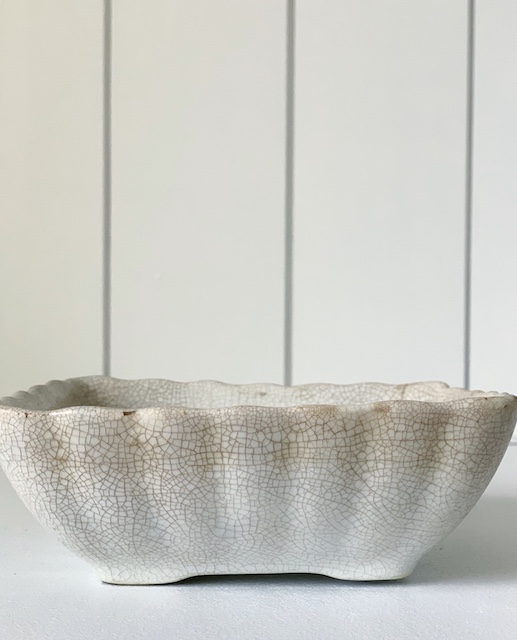
Ironstone is a type of stoneware that was developed in the 1800s. It was a cheaper alternative to porcelain and was easier to mass produce long ago. Ironstone is a more refined version of stoneware and sometimes can mimic the look of porcelain. It can be really hard to tell the difference between the two (porcelain and ironstone) actually, if you are not careful. You want to remember that ironstone will almost always be heavier than porcelain and tends to be more opaque than porcelain. But, unless a piece is marked, it can sometimes be impossible to tell the difference for sure.
Porcelain

Porcelain is made of clay that has a finer grain than stoneware and it is fired at a higher temperature than the other pieces I mentioned above. Porcelain is a very durable, strong material that can be used to create thin, delicate pieces. Ornate items like victorian vases with delicate leaves and flowers wouldn’t be possible to make with stoneware. Also, many porcelain pieces are transparent – you can lift up a piece to the light to see if it “glows!” Porcelain can be either hard paste (shiny and vitrified) or soft-paste (sandy when chipped). Common porcelain ceramics include bathroom tiles and tea cups (talk about both ends of the spectrum)! Also, porcelain tends to sound like a bell when you flick it while ironstone will sound more like a thump.
Some Of My Favorites
I gathered up a few of my favorites from each category for you all to look at! I hope you enjoy browsing them as much as I did!
Wrap Up

While I could write an entire post on each of these, I hope this little “Fridays at 5:00” helps you just a bit. It can be hard to tell what things are exactly sometimes when you are out shopping. If you’re lucky a piece will have a makers mark on the bottom that you can research, but, that isn’t always the case.
- I also want to mention that my friend on Instagram @lifevintageandmore has an excellent highlight button explaining collectible pottery – click here to check it out. She goes into detail about several of the pieces I talk about above!
In the end, I feel the best way to tell the difference between the different types of collectible pottery is to become familiar with them and spend time studying them in person. The more time you study the characteristics of each of these categories, the better you will be at recognizing and identifying them. But, I will be honest, I still question some of the pieces that I find when I am out hunting … even after all these years!

Cheers to the hunt my frinds!
One More Quick Fun Fact: We have all heard of transferware, right! Well, just in case you were wondering, according to the Transferware Collectors Club, “transferware can be earthenware or porcelain, ironstone or bone china.”

I love sharing my passion for vintage – if you liked this post then you may also enjoy this post on dating old coke bottles or this post on blow molds.
*this post contains affiliate links

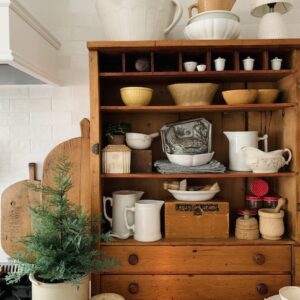 Rustic Kitchen Cabinet Styling
Rustic Kitchen Cabinet Styling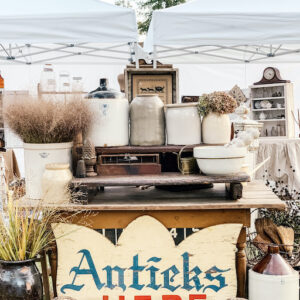 Fall Vintage Market Wrap Up
Fall Vintage Market Wrap Up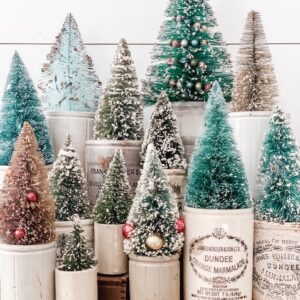 Bottle Brush Christmas Trees
Bottle Brush Christmas Trees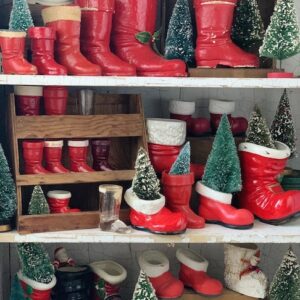 Vintage Santa Boots For Christmas
Vintage Santa Boots For Christmas


This was SUPER helpful Emily!! Thanks SO much for breaking it all down…I love it!